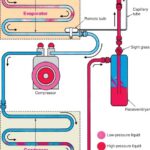It’s a common question, especially as the mercury drops: “How long should I warm up my car?” The simple answer is yes, you should let your engine warm up a bit, particularly when temperatures are frigid. While you don’t need to let it idle for an excessively long period, understanding why a brief warm-up is beneficial and separating fact from fiction is key to taking care of your vehicle.
In extremely cold conditions, for example, around -10 degrees Celsius (14 degrees Fahrenheit), giving your car an extra minute or two to warm up can be advantageous. This allows the temperature to even out across different engine components. Starting your car and immediately pushing it to its limits under heavy load in very cold weather could cause issues. The different rates at which materials expand could put stress on components like the head gasket, potentially weakening the seal between the crankcase and cylinder head over time and leading to future failures.
Another significant factor in cold weather is the viscosity of engine oil. As temperatures plummet, oil thickens, making it harder to pump and reducing its effectiveness as a lubricant. Allowing the engine and oil to warm up helps the oil flow more freely and properly lubricate critical engine parts.
However, it’s also important to address some persistent myths surrounding engine warm-up that often lead to unnecessary idling and confusion. Let’s clarify some common misconceptions:
Debunking Common Car Warm-Up Myths
There are several outdated beliefs about why older engines supposedly needed extended warm-up times. These myths often persist even with modern vehicles.
Myth 1: Carbureted Engines Needed Long Warm-Ups
The idea that carbureted engines required lengthy warm-ups due to the carburetor itself is a misconception. While carburetors use a choke to enrich the fuel mixture during cold starts, running with the choke engaged doesn’t inherently harm your engine. It does cause the engine to run richer, which, while potentially leading to spark plug fouling or carbon buildup over extended periods, won’t cause immediate engine damage. In fact, a richer fuel mixture can even offer some benefits, such as cooler exhaust temperatures and better lubrication for exhaust valves and valve seats.
Myth 2: Warming Up Your Car is a Waste of Fuel
The argument that warming up your car is simply a waste of fuel often sidesteps the original question. While fuel consumption from idling is a valid environmental concern, it’s a separate issue from the question of whether or not warming up your car is beneficial for the engine. The focus here is on engine health and longevity, not fuel efficiency in this specific context.
Myth 3: New Engines Made of Aluminum Don’t Need Warm-Ups
The claim that only old cast iron blocks needed warm-ups and that modern aluminum engines are exempt is inaccurate. Cast iron blocks are not inherently prone to cracking when started cold. This myth lacks evidence and scientific backing.
Myth 4: Piston Rings Reseat During Warm-Up
The notion that piston rings “reseat” themselves when an engine warms up from cold is false. Piston rings are already seated and worn in from engine use. Idling the engine to warm it up will not cause them to reseat or change their existing condition.
Myth 5: Engines Need Time for Oil to Circulate
The idea that there’s a significant delay in oil circulation upon starting the engine is incorrect. Modern engines are designed to circulate oil almost immediately upon startup. It’s a very rapid process, not one that requires extended idling time.
Myth 6: Aluminum Pistons Expand Faster and Cause Seizing
The concern about aluminum pistons expanding faster than steel cylinder liners and causing engine seizure is largely outdated, especially with modern engine technology. Modern pistons are often made from hypereutectic alloys. These alloys are designed with a lower coefficient of thermal expansion, allowing for tighter tolerances within the engine without the risk of seizing due to expansion. Hypereutectic alloys are engineered at a eutectic point, a specific mixture where the alloys become integrated at a molecular level, offering enhanced properties. In short, piston expansion is not a significant concern in contemporary vehicles.
Conclusion: A Balanced Approach to Warming Up Your Car
While excessively long warm-up times are unnecessary and contribute to fuel waste and emissions, a brief warm-up, especially in cold weather, is still a good practice. It ensures proper oil circulation, reduces stress on engine components due to thermal expansion differences, and ultimately contributes to the longevity of your engine. For modern cars, generally, 30 seconds to a minute of idling before driving off gently is sufficient in most cold weather conditions. In extremely cold temperatures, extending this to a couple of minutes can provide added protection. Focus on driving gently for the first few minutes as the engine comes up to full operating temperature rather than prolonged idling.

